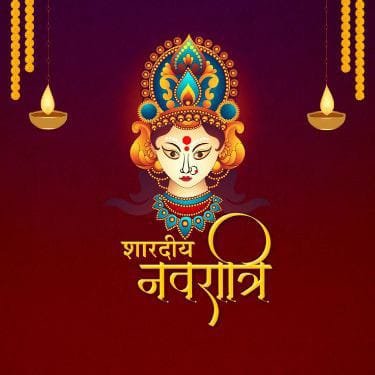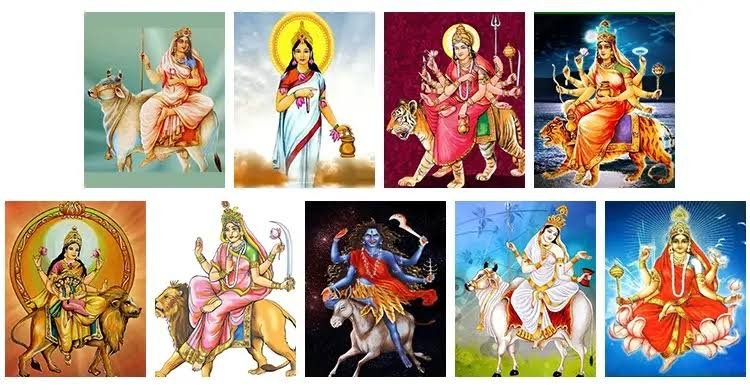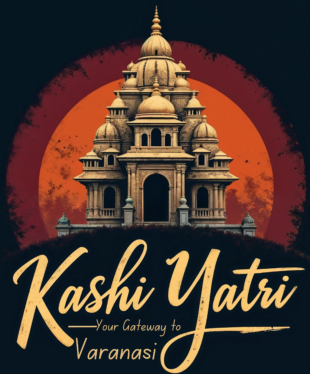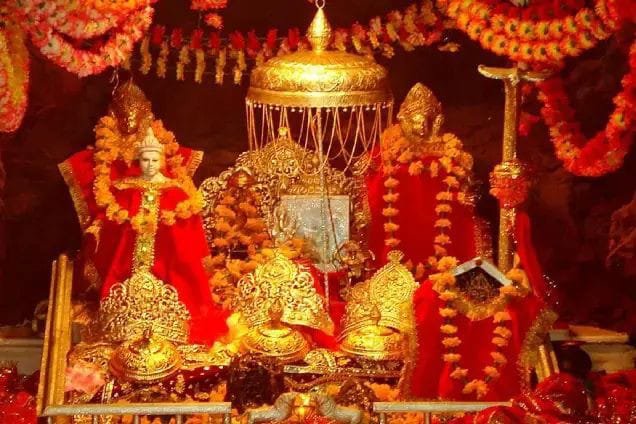This is an introduction to Shardiya Navratri 2024, which is a time of spiritual awakenin
The Navratri festival is one of the most revered and anticipated Hindu celebrations, and it is celebrated not just in India but also by Hindus all over the world. The victory of good over evil, the triumph of light over darkness, and devotion to the goddess Durga, who is worshiped in her nine divine incarnations, each of which represents a different facet of the feminine divinity, are all aspects that are symbolized by this emblem. A special place is reserved for Shardiya Navratri, which occurs during the autumn season, often in the month of Ashwin (September-October). This is because it signifies the beginning of the festive season that leads up to Diwali.

The auspicious Kalash Sthapana, also known as the placement of the sacred urn, signifies the beginning of Shardiya Navratri in the year 2024. This event establishes the spiritual tone for the nine days of devotion and worship that follow. This article will walk you through the Navratri Puja Vidhi, which are the worship rites, as well as the Shubh Muhurat, which are the auspicious dates, and the profound importance of the Akhand Jyoti, which is a symbol of everlasting trust and devotion to Goddess Durga.
Within the context of Hinduism, the significance of Shardiya Navratri
Navratri is more than just a religious festival; it is a time for self-purification, meditation, and reconnecting with one’s spiritual roots. The name ‘Navratri’ translates to ‘nine nights’ in Sanskrit, where each night is dedicated to the worship of the nine manifestations of Goddess Durga, collectively known as ‘Navdurga.’
The event bears enormous importance in Hinduism because it honors the feminine divine element, also known as ‘Shakti.’ Navratri depicts the unending war between good and evil, where Goddess Durga triumphs over the monster Mahishasura, marking the victory of good over evil. For devotees, Navratri is an occasion to seek blessings for health, wealth, and protection from harmful forces.
Kalash Sthapana: The First Ritual of Shardiya Navratri 2024
What is Kalash Sthapana?
Kalash Sthapana, also known as Ghatasthapana, is the first and most important ceremony that initiates Navratri. The Kalash, or the sacred urn, depicts the universe and is thought to harbor the presence of the divine. Performing Kalash Sthapana in a proper manner ensures the success of the Navratri rituals and attracts Goddess Durga into the home for the duration of the festival.

Steps to Perform Kalash Sthapana in Shardiya Navratri 2024:
- Choosing the Direction: According to Vastu Shastra, the Kalash should be placed at the northeast corner (Ishan Kon), which is regarded the most auspicious for worship. This direction is thought to promote spiritual energy and provide a sacred setting for the puja.
- Preparing the Kalash: A copper or clay pot is perfect for Kalash Sthapana. Begin by adorning the pot with a Swastika emblem made of vermillion (roli). Tie a red or yellow sacred thread (mouli) around the neck of the Kalash.
- Filling the Kalash: Fill the Kalash with pure water, preferably combined with Ganga jal (holy water from the Ganges), to purify the space. Add durva grass, betel nuts, rice grains (akshat), and a silver coin for prosperity.
- Placing the Coconut: On top of the Kalash, place a fresh coconut covered in a crimson cloth, fastening it with a mouli. The coconut signifies fertility and creation, while the red fabric represents power and purity.
- Sprouting Barley (Jau): In a separate clay pot, sow barley seeds in fertile soil, which will develop during the nine days of Navratri, symbolizing new beginnings and prosperity. The sprouted barley is also offered to the Goddess at the end of the event.
- Praying for Blessings: Once the Kalash is built, devotees give prayers, ignite incense sticks, and begin their nine-day-long devotion by reading sacred scriptures such as the Durga Saptashati or Durga Chalisa.
The Significance of Akhand Jyoti in Shardiya Navratri
One of the most respected features of Navratri is the lighting of the Akhand Jyoti, an immortal flame that burns constantly throughout the nine days of the festival. It is symbolic of the undying trust and devotion to Goddess Durga and is said to invoke her divine benefits. The Akhand Jyoti depicts the eternal light of knowledge, wisdom, and spirituality, overcoming darkness and ignorance.
Why is Akhand Jyoti Lit During Shardiya Navratri?
- Symbol of Devotion: The continuous burning of the Akhand Jyoti indicates the constant devotion of the devotees to Goddess Durga. It is thought that as long as the flame remains lit, the divine force of the Goddess is present in the home, safeguarding the family from all danger.
- Spiritual Significance: The flame is considered as a bridge between the physical and spiritual realms. It represents the light of the soul and is thought to be a beacon that guides followers toward spiritual enlightenment.
- A Source of Divine Energy: Many devotees believe that the Akhand Jyoti transfers the cosmic energy of Goddess Durga into the family, infusing the space with pleasant vibrations and divine protection. It is regarded a wellspring of divine benefits that wards off evil and gives serenity and prosperity.
- Maintaining the Flame: Traditionally, the Akhand Jyoti is maintained by using clarified butter (ghee) or mustard oil in a huge diya (light), ensuring that it does not extinguish for the full duration of Navratri. Devotees take turns watching over the flame, ensuring it remains steady and bright.
The Nine Forms of Goddess Durga: A Day-by-Day Worship Guide
During Navratri, followers worship the nine avatars of Goddess Durga, each representing a distinct component of feminine strength Adishakti. Here is a breakdown of the nine forms of the Goddess and the significance of each day:

- Day 1 – Maa Shailputri: The first day is devoted to Maa Shailputri, the daughter of the Himalayas. She signifies strength, courage, and loyalty. Worshiping her brings stability and strength in life.
- Day 2 – Maa Brahmacharini: The second day is for Maa Brahmacharini, who embodies penance and austerity. Her worship brings peace, insight, and determination to conquer trials.
- Day 3 – Maa Chandraghanta: On the third day, Maa Chandraghanta is revered. She is the Goddess of peace, tranquility, and wealth. She helps remove impediments and assures the safety of her believers.
- Day 4 – Maa Kushmanda: The fourth day is dedicated to Maa Kushmanda, who is thought to be the creator of the universe. Her blessings provide health, money, and happiness.
- Day 5 – Maa Skandmata: On the fifth day, Maa Skandmata, the mother of Lord Kartikeya, is adored. She provides her followers with love, affection, and safety for their children.
- Day 6 – Maa Katyayani: The sixth day is dedicated to Maa Katyayani, who is adored for conquering evil forces. Devotees seek her blessings for strength and triumph over adversaries.
- Day 7 – Maa Kalaratri: Maa Kalaratri, the fiercest form of Goddess Durga, is honored on the seventh day. She is said to eradicate ignorance and darkness, bringing light into the lives of her believers.
- Day 8 – Maa Mahagauri: The eighth day is for Maa Mahagauri, who represents purity, tranquility, and harmony. Worshiping her helps purify the soul and erase sins.
- Day 9 – Maa Siddhidatri: On the final day of Navratri, Maa Siddhidatri is honored. She is supposed to give wisdom, success, and spiritual enlightenment.
Shubh Muhurat and Navratri 2024 Timings
Navratri rites are regarded particularly fortunate when performed within specific timings known as Shubh Muhurat. The Shubh Muhurat for Kalash Sthapana and other major rituals are determined from planetary configurations and must be followed for the best spiritual outcomes.
Key Shubh Muhurats for Shardiya Navratri 2024:
- Kalash Sthapana: The Shubh Muhurat for Kalash Sthapana happens on the first day of Navratri. It is commonly performed in the morning hours, between 6:00 AM and 8:00 AM, but particular timings may vary according on location.
- Chanting and Devotional Practices: Throughout Navratri, devotees recite mantras, study religious texts, and perform aarti (worship with light). The most opportune period for these activities is during Brahma Muhurat, which is around one and a half hours before sunrise.
Fasting During Navratri: Spiritual and Physical Benefits
Fasting during Navratri is an age-old ritual that is thought to purify the mind, body, and spirit. Many followers observe a severe fast, consuming only fruits, milk, and light meals made from non-grain products like buckwheat flour with water chestnut flour. Fasting not only aids in detoxifying the body but also boosts concentration during prayers.
Types of Fasts Observed During Navratri:
- Nirjala Fast: In this fast, followers abstain from both food and water for the entire nine days. It is regarded the most demanding yet extremely lucrative in terms of spiritual growth.
- Phalahar Fast: In this style of fasting, devotees consume only fruits and milk products, eschewing grains and legumes. This is one of the most prevalent kinds of fasting during Navratri.
- Satvik Bhojan Fast: Devotees eat only a single meal a day, consisting of vegetarian meals without onion, garlic, or seasonings. This meal is consumed after offering prayers to the Goddess in the evening.
Conclusion: Navratri 2024 – A Time to Seek Divine Blessings

As Shardiya Navratri 2024 begins, devotees across the world will immerse themselves in devotion, prayers, and fasting to seek the blessings of Goddess Durga. The lighting of the Akhand Jyoti, the singing of mantras, and the performing of Kalash Sthapana rites create a spiritual atmosphere that fills the home with divine energy.
Let this Navratri be a time of spiritual awakening, self-reflection, and inner calm as we welcome the Goddess into our homes and hearts. May Goddess Durga bless you with health, money, and happiness throughout these auspicious nine days of devotion.
Jai Mata Di!







